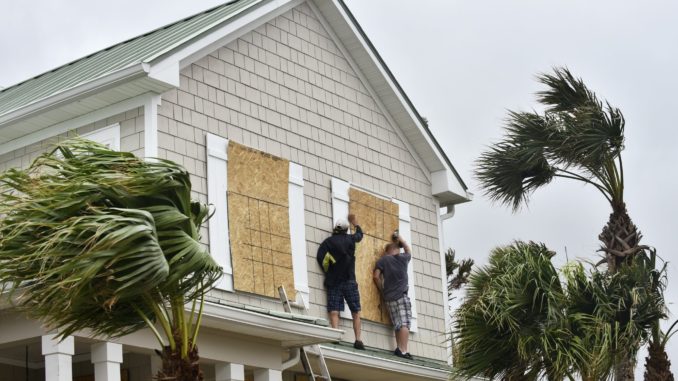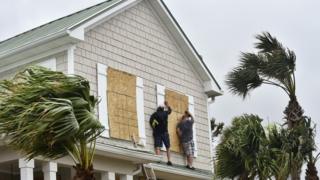
Hurricane Matthew: Florida warned of ‘direct hit’
-
6 October 2016
- From the section US & Canada
 Image copyright
Image copyright
AP
In Florida residents are being warned of “catastrophic” damage
Florida residents have been warned to prepare for a “direct hit”, as Hurricane Matthew pounded the Bahamas after devastating parts of Haiti.
Damage could be “catastrophic”, the state governor said. Evacuation orders have been issued along the coast.
Matthew, with winds of 115mph (185km/h), is expected to strengthen and hit Florida as a Category Four storm, US officials say.
It has swept across the Caribbean, with the worst of the damage in Haiti.
At least 22 people have been killed in Haiti and thousands displaced. The storm has forced the presidential election there to be postponed.
Four people were also killed in the neighbouring Dominican Republic.
- Hurricane Matthew in pictures
- Animated guide: Hurricanes
- Struggle to reach Haitian storm zone
- Haitians describe hurricane ordeal
As of 0600GMT, the storm was over the Bahamas, where all air and sea traffic has been halted and people urged to move to higher ground.
People living on some southern shores are facing storm surges, officials warned.
Hurricane Matthew was expected to pass near Grand Bahama Island and “move very close” to the east coast of the Florida peninsula on Thursday night, the US National Hurricane Center (NHC) said.
“Everyone in our state must prepare now for a direct hit,” Florida Governor Rick Scott told a news conference.
“If Matthew directly impacts Florida, the destruction could be catastrophic and you need to be prepared.”
Florida’s history of hurricanes
- October 2005: Hurricane Wilma, Deaths were reported in Haiti, Mexico, Cuba. Struck Florida as a Category Three, killing five people. South Florida suffered widespread damage
- August 2004: Hurricane Charley. Struck Florida as a Category Four, killing nine and causing billions of dollars in property damage
- August 1992: Hurricane Andrew. Category Five storm struck South Florida, killing 44 and damaging more than 125,000 houses
Some two million people have been advised to evacuate across coastal areas of Florida, Georgia and South Carolina.
“If there is an evacuation order in your community, you need to take it seriously,” US President Barack Obama said.
Cars queued for fuel and residents stocked up on food in affected areas, local reports said.
In South Carolina, the lanes on a section of major highway were reversed so vehicles could head west away from the storm.
Image copyright
AFP
In Florida residents are being warned of “catastrophic” damage
Image copyright
AP
In some areas of Florida, motorists have been queuing to fill their cars
Image copyright
AFP
The storm passed from Haiti to Cuba, damaging buildings
Image copyright
Reuters
Rescue workers warn that the scale of the damage in Haiti is still not known
In Haiti, meanwhile, rescue workers are struggling to reach areas cut off by the storm.
Officials said they were not yet in a position to gauge the true extent of the damage – particularly in the Grand Anse area, which was directly in the storm’s path.
A key bridge had been destroyed, roads were impassable and phone communications were down, officials said.
Mourad Wahba, the UN special representative for Haiti, said at least 10,000 people were in shelters and hospitals were overflowing.
At the scene: Tony Brown, BBC News, Haiti
We only began to see the real destructive force of Hurricane Matthew once we moved towards the south-west of the country.
Trees fallen, banana crops uprooted and flattened, houses under water and men and women trying to get the debris out of the way.
It was noticeable how the people we passed were coping alone. There were no army or police around to help. Even the aid agencies are struggling to move around this damaged corner of the country.
“It’s not looking good,” said Jean Claude Fignole, programme director in Haiti for the aid agency Oxfam,
“We’re getting reports out of the southwest of Haiti… reports of schools that have been completely destroyed, many homes that have been destroyed.”
Matthew is the region’s most powerful hurricane since Felix in 2007.
Hurricane scales
Category one: sustained winds of 74-95mph (119-153 km/h); some damage and power cuts
Category two: winds of 96-110mph (154-177 km/h); extensive damage
Category three: winds of 111-129mph (178-208 km/h); well-built homes suffer major damage
Category four: winds of 130-156mph (209-251 km/h); severe damage to well-built homes, most trees snapped or uprooted
Category five: winds of 157 mph (252 km/h) or higher; high percentage of homes destroyed, area uninhabitable for weeks or months
Source: NOAA
